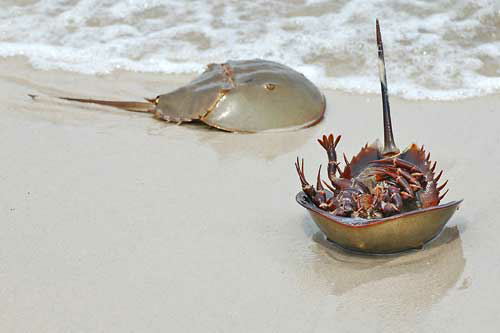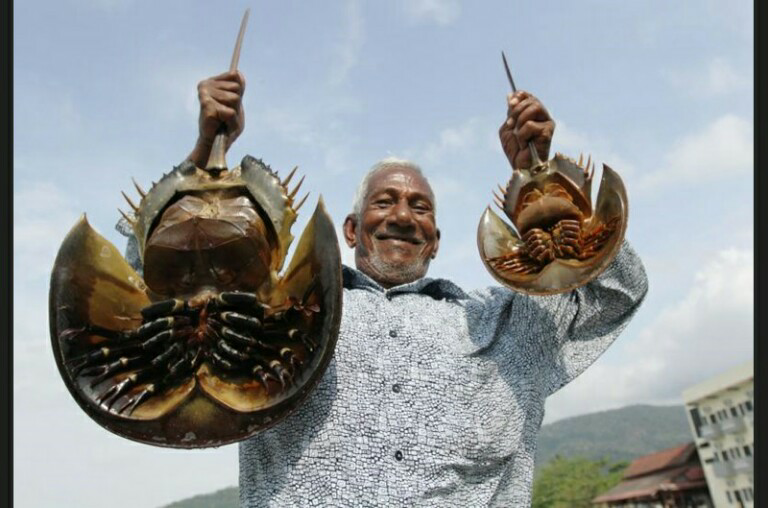Trimmed / mimi is one of the strangest marine animals ever known by humans. The first strangeness can clearly be seen in its form other than other sea creatures. At first glance, his body is shaped like a stingray with stiff & hard skin. The shape of the front body is also considered similar to the shape of a horseshoe so that abroad, belangkas often called by the name "horseshoe crab" (horseshoe crab).( )
)
Trimmed in the staircase of scientific classification belongs to the phylum of Arthropoda (animal in segments) where animals such as crabs, insects, and centipedes are also included in this phylum. The basis of the classification is because the cage has 6 pairs of legs & body sections. There are four species of crops known to humans and still live in the present where the four species are classified into the family Limulidae. As for the places that become native habitat of pruning is the Asia Pacific coast (including Indonesia), South Asia, & North America the southeast part.
ANATOMY & MORPHOLOGY
It has been alluded to in the beginning if the belimbas have a shape similar to that of a stingray. The body of the crop is entirely covered by a hard & brownish shell. In terms of anatomical, the body of the split is divided into 3 main parts, each separated by a thin joint or segment: head (prosoma), stomach (opisthosoma), & tail (telson). At the head of the cage there are 9 eyes that lie scattered: 1 on each side of the head, 5 on the front, & 2 at the bottom of the head.
Below the lower body. (Source)
The tail portion of the barrel is rigid & conical at the edges, but the base can be moved & able to give the impetus to move faster. The ability of the tail of the tail then led to the theory that if the tail of the crop is damaged or lost, then the corresponding crop will be more easily captured by the predator. Because of its tail, in the scientific classification ladder, the order of the chains is named Xiphosura which is the Greek word for "sword tail".
If the body is trimmed backwards, you will see the legs of a crop that looks like a crab or spider's legs. Total, have six pairs of legs that have their respective functions. The first pair of legs is useful for holding food & putting it into the mouth. The second pair of legs is used for walking on the seabed, while the remaining 4 pairs are used to provide additional thrust during the moving trellis. Although the cage can swim & float in the water by wearing its tail & legs, it trims more moving by walking & crawling on the seafloor.

HUMAN RELATIONSHIPS
Some of the moderate trimmings
gathered on the beach. (Source)
Trimming has a number of important benefits for humans. Since the beginning of the twentieth century, crops were captured in large quantities to feed the eels & large sea slugs. Outside of the fishing industry, blood from copper-clogged mugs is used by the pharmaceutical industry to make Limulus Amebocyte Lysate (LAL), a useful compound for detecting toxins produced by bacteria. The shells from the spines can be processed into various products such as contact lenses, skin creams, patches of head sutures, & chitosan, a kind of food preservative. In some areas of Indonesia, crops are also eaten by humans.
The great benefits humans derive from cropping on the other hand also contribute greatly to its presence in the wild. Overcrowded capture makes the animal population decline sharply & starts to endangered. In addition to consumed & used as industrial raw materials, belangkas also often killed by the shrimp farmers because the belangkas is considered a pest that eat shellfish. Other factors such as habitat destruction & pollution also contribute to the decline of the crop population.
The greatest challenge of the crop conservation effort is the cropping of animals that are difficult to multiply rapidly & there are so many industries that rely their fortunes on hoards. As a first step to prevent the extinction of the spines, scientists are closely watching the wildlife cycles in their wild habitats in hopes of finding the most effective way to preserve the pruning. Some states in the US such as New Jersey & South Carolina are even acting more extreme by banning the culling of altogether.
As a follower of @followforupvotes this post has been randomly selected and upvoted! Enjoy your upvote and have a great day!